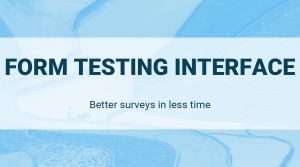Given the dynamic challenges presented by COVID-19, collecting data using remote methods is important to the safety and protection of people–enumerators, respondents, field managers–and the data they are collecting. As SurveyCTO’s global users collect data across 165 countries and thousands of languages, multilingual web forms have always been a core feature of SurveyCTO. To improve convenience, data quality, and the overall experience completing web forms, SurveyCTO introduces new functionality to translate the entire web form interface–such as button labels, error messages, and even the generic text at the beginning and end of the web form–into any language, including those with non-Latin fonts and written right-to-left.
This new translation functionality allows users to seamlessly adapt to and serve a multilingual respondent population. So when a Spanish-speaking respondent opens a web form, for example, the form and interface will automatically appear in Spanish. Likewise, when a French-speaking respondent opens the same form, it is automatically presented in French. SurveyCTO provides options to translate the web form interface into English, French, Spanish, and Hindi, but any other language can be uploaded using translation tables. A catalog of translation tables–including Portuguese (European), Portuguese (Brazilian), Arabic, and Burmese–created by users like Oxfam, is also available to the global community of SurveyCTO users. We’ll continue to build the catalog with new translations with support of our users.
What’s possible with the new web form interface translation feature set?

This new functionality provides more comprehensive translation to improve and ease the respondent experience of navigating and completing web forms, resulting in better quality data. Highlights of the feature set include:
- Language auto-detection for convenience: Enjoy an improved web form experience with built-in automatic language detection, which ensures the web form interface is the same as the respondents’ browser language. If a respondent opens a web form using a browser in Hindi, for example, SurveyCTO automatically detects the browser language and switches to the Hindi web form and Hindi web form interface.
- Translate to any language and then share it: To add a translation for any language other than the four automatically available–English, French, Spanish, and Hindi–or the languages available in the catalog of translation tables, you can easily create your own translation table. Users do this using the translation table template, which is a simple .csv file containing the list of all words that appear in the web form interface. Once the translation table is uploaded into the Configure tab of the server console and selected, it translates the web form interface. To share the translation table with other SurveyCTO users, add the translation table to SurveyCTO’s Github page. Here you’ll also find free-to-use translation tables created and shared by other users and organizations, such as the translation tables for Arabic and Burmese provided by Oxfam.
- Work in multilingual settings seamlessly: In addition to existing support for multilingual web forms, respondents who fill out multilingual web forms now have the ability to easily select the language they want for the web form interface. If the respondent switches the web form language mid-survey, the web form interface follows suit for an improved web form experience. For example, if a respondent feels more comfortable reading a specific question in Portuguese, instead of English, switching the web form language to Portuguese does the same for the web form interface.
- Plan for the unexpected with a second language: This functionality also provides the option to set a fallback language for the web form interface. This was designed for scenarios wherein an incomplete translation table is erroneously uploaded and used for a multilingual web form. SurveyCTO provides the ability to have another language relevant to the respondent population configured as the fallback language to ensure respondents complete the survey with minimum issues.
How do I get started translating my web form interface?
All SurveyCTO subscriptions automatically have web form interface translations for English, French, Spanish, and Hindi available in the language dropdown on every server console (see the above image). Other user-created translation tables for Arabic, Burmese, European Portuguese, and Brazilian Portuguese are also available to download and use for any project. To add a web form interface translation for any languages not included here, you can download the translation table template (the template can be found in the Configure tab under server settings) and follow the instructions provided to expand your translation options.
For more information, check out this Support Center guidance, product documentation, full release notes, and SurveyCTO’s Github page on translation tables.
If you create a translation table, we ask that you consider sharing your hard work with the global community of SurveyCTO users in the catalog of translation tables. Please contact us at info@surveycto.com with any questions, or if you need help making your translation table accessible to others.
Need technical support getting started?
If you’re a SurveyCTO user and have any questions about creating translations, our support team is available 24×7. Go to the Support Center and click on the link to “Submit a support request.”




